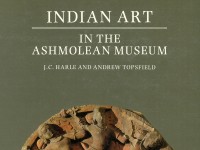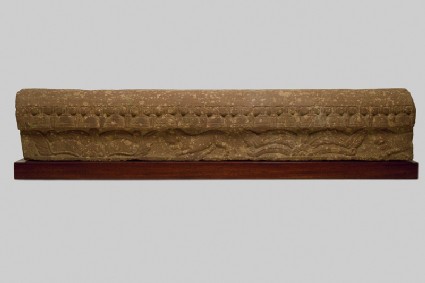Indian Art in the Ashmolean Museum
A catalogue of the Ashmolean’s collection of Indian art by J. C. Harle and Andrew Topsfield (published Oxford, 1987).

Publications online: 143 objects
- Reference URL
Actions
Coping stone from a carved railing
-
Literature notes
Such railings were in common use in the earliest periods to demarcate a sacred enclosure, whether it contained a holy tree, the throne of a yaksa or a stūpa [see EA1978.127 and EAOS.59]. Since at least fifteen other portions of this coping are known, the railing to which it belonged probably enclosed a large monument such as a stūpa. Apart from the crisply carved frieze of some beauty, the Ashmolean example also bears, on the reverse side, an inscription of historical importance in its entirety. It read: “Caused to be made by Kāsiputra Yaska, the confidant of King Sūryamitra, the son of Gopālī” (Härtel trans.).
The inscription provides evidence for the date and less clearly, for the original location of the railing. Professor Härtel has argued, on epigraphical grounds as well as from the style of the carving, for the less well-documented of two kings named Sūryamitra, who reigned in Pancāla, north-east of Mathura, in the first half of the 1st century A.D. The relatively small scale of the railing argues fro an early date [see EAX.391] but the frieze, in spite of its leaping lions separated by palmettes which distantly echo older western Asian motifs, is in a style quite compatible with an early 1st century A.D. date. The railing may have stood in Ahicchattra, the principal site in Pancāla, from which has come sculpture in the same style and distinctive stone at that of Mathura, and for which a sub-school of sculpture has been postulated; on the other hand, almost identical carved copings were excavated from the Kankālī Tīlā site in Mathura. Of the other nine inscribed portions, only one so far known, in a private collection in Calcutta, bears the full text. Two others are in the National Museum, New Delhi, one in the Los Angeles County Museum of Art. and one in the Museum für Indische Kunst, West Berlin. -
Description
Carved stone railings were commonly erected around stupas and other sacred enclosures. This coping stone with a frieze of lions and palmettes is one of a number of surviving portions from one such railing. An inscription on the back states that it was commissioned by ‘Kashiputra Yashaka, the confidant of King Suryamitra, the son of Gopali.’
-
Details
- Associated place
-
Asia › India › north India › Uttar Pradesh › Mathura district › Mathura (place of creation)
- Date
-
1st half of the 1st century AD
Kushan Period (AD 50 - 600)
- Associated people
-
Kashiputra Yashaka (active c. 1st half of the 1st century AD) (commissioner)
- Material and technique
- red sandstone
- Dimensions
- 18 x 97.8 x 13.6 cm max. (height x width x depth)
- Material index
- Technique index
- Object type index
- No. of items
- 1
- Credit line
- Purchased with the assistance of the E. H. North Bequest and the Friends of the Ashmolean Museum, 1983.
- Accession no.
- EA1983.24
-
Further reading
Harle, J. C., and Andrew Topsfield, Indian Art in the Ashmolean Museum (Oxford: Ashmolean Museum, 1987), no. 10 on p. 9, pp. xiv & 22, pl. 3 (colour) & p. 9
Hartel, Herbert, ‘An Early Coping Stone Inscription from Mathura’, Gouriswar Bhattacharya, ed., Deyadharma: Studies in Memory of Dr. D. C. Sircar, Sri Garib Dass Oriental Series No. 33 (Delhi: Sri Satguru Publications, 1986), pp. 101-102 & 106, illus. p. 105 figs 2a-2b
Ahuja, Naman, ‘Early Indian Art at the Ashmolean Museum - Catalogue in progress’, 2016, no. 91.1
Location
Objects are sometimes moved to a different location. Our object location data is usually updated on a monthly basis. Contact the Jameel Study Centre if you are planning to visit the museum to see a particular object on display, or would like to arrange an appointment to see an object in our reserve collections.
Galleries
Publications online
-

Indian Art in the Ashmolean Museum
Such railings were in common use in the earliest periods to demarcate a sacred enclosure, whether it contained a holy tree, the throne of a yaksa or a stūpa [see EA1978.127 and EAOS.59]. Since at least fifteen other portions of this coping are known, the railing to which it belonged probably enclosed a large monument such as a stūpa. Apart from the crisply carved frieze of some beauty, the Ashmolean example also bears, on the reverse side, an inscription of historical importance in its entirety. It read: “Caused to be made by Kāsiputra Yaska, the confidant of King Sūryamitra, the son of Gopālī” (Härtel trans.).
The inscription provides evidence for the date and less clearly, for the original location of the railing. Professor Härtel has argued, on epigraphical grounds as well as from the style of the carving, for the less well-documented of two kings named Sūryamitra, who reigned in Pancāla, north-east of Mathura, in the first half of the 1st century A.D. The relatively small scale of the railing argues fro an early date [see EAX.391] but the frieze, in spite of its leaping lions separated by palmettes which distantly echo older western Asian motifs, is in a style quite compatible with an early 1st century A.D. date. The railing may have stood in Ahicchattra, the principal site in Pancāla, from which has come sculpture in the same style and distinctive stone at that of Mathura, and for which a sub-school of sculpture has been postulated; on the other hand, almost identical carved copings were excavated from the Kankālī Tīlā site in Mathura. Of the other nine inscribed portions, only one so far known, in a private collection in Calcutta, bears the full text. Two others are in the National Museum, New Delhi, one in the Los Angeles County Museum of Art. and one in the Museum für Indische Kunst, West Berlin.
Notice
Object information may not accurately reflect the actual contents of the original publication, since our online objects contain current information held in our collections database. Click on 'buy this publication' to purchase printed versions of our online publications, where available, or contact the Jameel Study Centre to arrange access to books on our collections that are now out of print.
© 2013 University of Oxford - Ashmolean Museum



